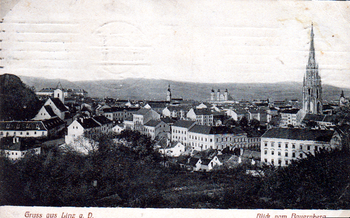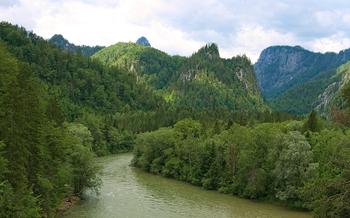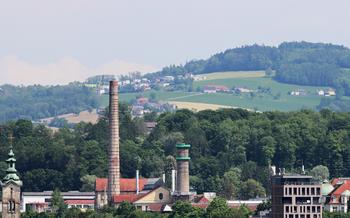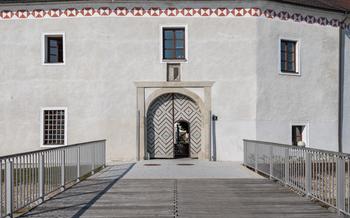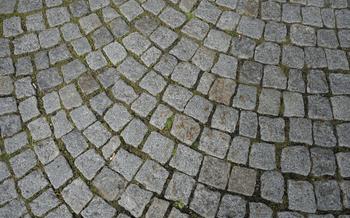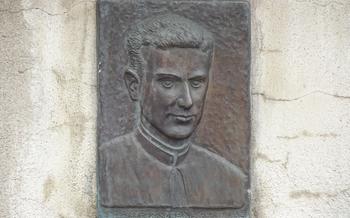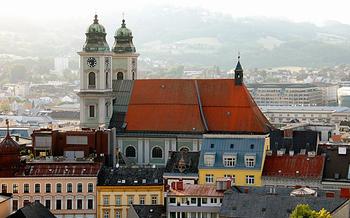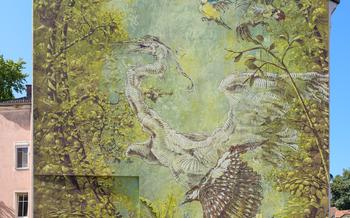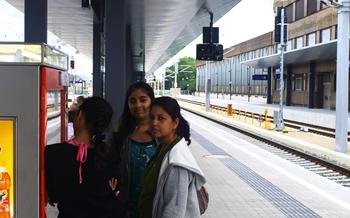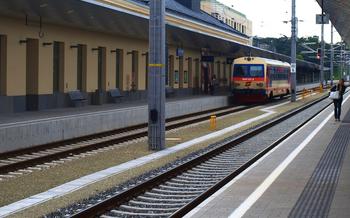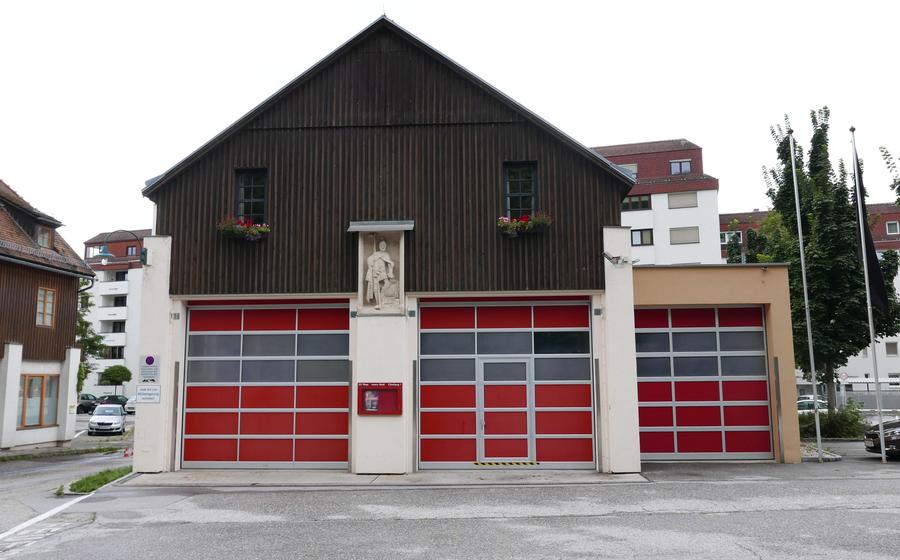
Wilhering Abbey
- Wilhering Abbey: A Cistercian Legacy
- Architectural Highlights
- Monastic Life
- Wilhering Abbey: A Treasure Trove of Cultural Heritage
- Guided Tours
- Exhibitions and Events
- Nearby Attractions
- Restaurants and Accommodation
- Photography and Videography
- Souvenirs and Gifts
- Accessibility and Parking
- Family-Friendly Activities
- Sustainability and Conservation
- Insider Tip:
Wilhering Abbey: A Cistercian Legacy
Founded in 1146 by monks from the Cistercian abbey of Rein, Wilhering Abbey holds a significant position in the religious and cultural history of Austria. As one of the most prominent Cistercian monasteries in the country, it played a pivotal role in spreading the Cistercian Order's influence throughout the region. Over the centuries, the abbey's spiritual and intellectual contributions deeply impacted the surrounding communities, leaving an enduring legacy that continues to captivate visitors today.
The architectural style of Wilhering Abbey reflects the transition from Romanesque to Gothic influences. Its imposing facade, adorned with intricate carvings and stunning stained glass windows, showcases the abbey's artistic prowess. Inside, visitors are greeted by an awe-inspiring nave, soaring vaulted ceilings, and ornate altars, each telling a unique story about the abbey's rich past.
Architectural Highlights
Wilhering Abbey stands as a testament to the architectural prowess of the Cistercian order. Its imposing facade captivates visitors with its intricate carvings, delicate tracery, and a stunning rose window that casts a kaleidoscope of colors onto the interior. The abbey's exterior is a harmonious blend of Romanesque and Gothic styles, showcasing the transition between these two architectural eras.
Venturing inside, visitors are greeted by a breathtaking nave that soars upwards, supported by elegant columns and ribbed vaults. The vaulted ceilings are adorned with intricate frescoes and paintings, depicting biblical scenes and the lives of the saints. The high altar, a masterpiece of Baroque art, is a focal point of the interior, adorned with sculptures, gilding, and vibrant colors that create a sense of awe and reverence.
Wilhering Abbey is home to numerous chapels, each with its own unique character. The Lady Chapel, dedicated to the Virgin Mary, features a graceful Gothic design and delicate stained glass windows that bathe the interior in a soft, ethereal light. The Chapter House, where the monks gathered for meetings and discussions, boasts an impressive collection of 17th-century choir stalls, intricately carved with scenes from the Bible and the lives of the Cistercians.
Monastic Life
Wilhering Abbey was home to a community of Cistercian monks who dedicated their lives to prayer, work, and community. Guided by the strictures of the Benedictine Rule, they followed a regimented daily routine that emphasized spiritual growth and self-sufficiency. The monks rose before dawn for prayers and then engaged in manual labor, tending to the abbey's extensive lands and workshops. They were skilled craftsmen, producing everything they needed from food and clothing to books and furniture.
The abbot, elected by the community, held a position of great responsibility. He was both the spiritual leader and the administrator of the abbey, responsible for its spiritual and material well-being. The abbot's authority was absolute, but he was also expected to be a humble servant of his community, leading by example and embodying the values of compassion, humility, and obedience.
The monks of Wilhering Abbey lived in a close-knit community, sharing meals, prayers, and work. They found solace and strength in their shared faith and commitment to their monastic vows. Their simple and austere lifestyle allowed them to focus on their spiritual development, seeking a deeper connection with God through prayer, contemplation, and service to their community.
Wilhering Abbey: A Treasure Trove of Cultural Heritage
Wilhering Abbey boasts a rich cultural heritage that extends beyond its religious significance. The abbey houses an extensive library, a collection of manuscripts, and various works of art that offer a glimpse into the intellectual and artistic pursuits of the Cistercian monks.
The library, with its impressive collection of books and manuscripts, serves as a testament to the abbey's role as a center of learning and scholarship during the Middle Ages. Visitors can marvel at the intricately illuminated manuscripts, which showcase the artistic talents of the monks and provide valuable insights into the abbey's history and religious practices.
Wilhering Abbey is also home to a notable collection of artworks, including paintings, sculptures, and stained glass windows. These works of art adorn the abbey's interior, adding to its visual splendor and reflecting the monks' appreciation for beauty and craftsmanship. Visitors can admire the expressive paintings that depict religious scenes, the intricately carved sculptures that grace the abbey's walls, and the stunning stained glass windows that bathe the interior in a kaleidoscope of colors.
The abbey's cultural heritage is further enriched by the many events and traditions that have taken place within its walls over the centuries. Visitors can attend concerts, exhibitions, and lectures that delve into the abbey's history, art, and music. These events provide an opportunity to experience the abbey's vibrant cultural legacy firsthand and gain a deeper understanding of its enduring significance.
Guided Tours
Wilhering Abbey offers guided tours that provide visitors with an in-depth exploration of its history, architecture, and monastic life. These tours are led by knowledgeable guides who share fascinating insights and anecdotes about the abbey's past and present. The typical itinerary of a guided tour includes visits to the abbey church, the cloister, the chapter house, and the library. Visitors will learn about the abbey's founding, its role in the Cistercian order, and its contributions to the region's religious and cultural development.
Guided tours of Wilhering Abbey are available daily at specific times. Visitors can check the abbey's website or contact the abbey directly for more information on tour schedules, prices, and reservations. Special tours or programs may also be arranged for groups or individuals with specific interests, such as architecture, history, or spirituality.
Exhibitions and Events
Wilhering Abbey regularly hosts a variety of exhibitions and events that showcase its rich cultural heritage and provide visitors with unique and enriching experiences. These exhibitions often delve into the history of the abbey, its architecture, its monastic community, and its impact on the region's cultural and religious development.
Visitors can explore temporary art exhibits featuring works by local and international artists, immersing themselves in the creative expressions inspired by the abbey's serene atmosphere. Historical displays shed light on the abbey's past through artifacts, documents, and interactive presentations, offering a glimpse into the lives of the Cistercian monks and the events that shaped the abbey's history.
Throughout the year, the abbey also hosts musical performances, concerts, and recitals, featuring talented musicians and vocalists. These events fill the abbey's sacred spaces with enchanting melodies, creating an unforgettable auditory experience for visitors.
To stay updated on the abbey's upcoming events and exhibitions, visitors are encouraged to check the abbey's website or social media pages. The abbey's events calendar provides detailed information on dates, times, and admission fees, allowing visitors to plan their visit accordingly.
Nearby Attractions
Enhancing your visit to Wilhering Abbey, the surrounding region offers an array of captivating attractions that complement your historical and cultural immersion. Venture just a short distance from the abbey to discover hidden gems and significant landmarks that further enrich your Austrian adventure.
-
Kremsmünster Abbey: Located approximately 20 kilometers from Wilhering Abbey, Kremsmünster Abbey boasts a rich history dating back to the 8th century. Explore its stunning Baroque architecture, marvel at its impressive library housing over 100,000 volumes, and uncover the secrets of its astronomical observatory.
-
Steyr Old Town: Immerse yourself in the charm of Steyr's Old Town, a picturesque urban gem situated a mere 15 kilometers from Wilhering Abbey. Wander along its cobblestone streets, admire the colorful facades of medieval buildings, and soak up the vibrant atmosphere of this enchanting town.
-
Enns Old Town: Steeped in historical significance, Enns Old Town lies approximately 25 kilometers from Wilhering Abbey. Step back in time as you explore its well-preserved medieval fortifications, visit the 12th-century Enns Castle, and delve into the town's fascinating past.
-
Mauthausen Concentration Camp Memorial: Pay your respects at the Mauthausen Concentration Camp Memorial, a somber reminder of Austria's dark past during World War II. Located approximately 30 kilometers from Wilhering Abbey, the memorial honors the victims of this horrific chapter in history and serves as a powerful reminder of the importance of peace and tolerance.
Restaurants and Accommodation
For a satisfying culinary experience, visitors can explore the charming restaurants and cafes in the vicinity of Wilhering Abbey. The "Gasthof Kirchenwirt," located just a stone's throw away, serves up traditional Austrian cuisine with a modern twist, using fresh, local ingredients to create delectable dishes. For a taste of international flavors, "Ristorante Pizzeria La Fontana" offers a delightful menu of Italian specialties, including wood-fired pizzas and homemade pasta.
If you seek a tranquil retreat after your exploration of the abbey, consider extending your stay at one of the nearby accommodations. The "Hotel Restaurant Kirchenwirt" provides comfortable rooms and suites, each adorned with a unique charm, ensuring a restful stay. Alternatively, the "Gasthof zum Goldenen Hirschen" offers a more traditional ambiance, with cozy rooms and a warm atmosphere. Both establishments are conveniently situated within walking distance of the abbey, allowing you to fully immerse yourself in the historical and cultural wonders of Wilhering.
Photography and Videography
Wilhering Abbey presents a picturesque subject for photographers and videographers, offering a wealth of architectural details, serene landscapes, and evocative interiors to capture. While photography and videography are generally permitted within the abbey's premises, there are a few guidelines to keep in mind to ensure respect for the sacred space and the privacy of the monks.
Respectful Photography
When photographing or filming within the abbey, it's essential to be mindful of your surroundings and the other visitors. Avoid using flash photography, as it can be disruptive and disrespectful during religious services or guided tours. Additionally, refrain from taking photos or videos of individuals without their consent, especially during private moments or prayer.
Best Times for Photography
The abbey's beauty varies throughout the day and year, offering unique photographic opportunities depending on the lighting conditions. For stunning exterior shots, consider visiting during the golden hours of sunrise or sunset when the abbey's facade glows with a warm, ethereal light. For capturing the interior's grandeur, opt for a cloudy day or visit during off-peak hours to avoid harsh shadows and crowds.
Creative Perspectives
To capture unique and memorable shots of Wilhering Abbey, experiment with different perspectives and angles. Explore the abbey's grounds, seeking out secluded corners, hidden details, or vantage points that offer a fresh perspective on the architecture. Don't hesitate to venture beyond the main attractions; the abbey's courtyards, cloisters, and gardens often reveal unexpected beauty and tranquility.
Souvenirs and Gifts
Within the abbey's premises, visitors will find a charming gift shop offering a diverse selection of souvenirs and gifts to commemorate their visit. From intricately designed postcards featuring stunning views of the abbey's exterior and interior to informative books delving into its rich history and significance, there's something for every taste and interest.
For those seeking a spiritual memento, the gift shop offers a range of religious items, including rosaries, crucifixes, and beautifully crafted icons. These pieces serve as tangible reminders of the abbey's enduring spiritual legacy and provide a tangible connection to its sacred atmosphere.
Additionally, visitors can discover a collection of locally-made crafts, showcasing the talents and creativity of the region's artisans. These unique and handcrafted items, such as pottery, textiles, and jewelry, offer a delightful way to support local communities while bringing home a piece of Wilhering Abbey's charm.
Among the most sought-after souvenirs is the abbey's very own honey, produced by the resident beekeepers who tend to the abbey's apiary. This sweet and golden liquid, infused with the essence of the abbey's surroundings, is a true delicacy and a testament to the abbey's commitment to sustainable practices.
Accessibility and Parking
Wilhering Abbey is easily accessible by car, with ample parking facilities available for visitors. The abbey's parking lot is located a short walk from the main entrance, providing convenient access for all visitors. Designated parking spaces are reserved for disabled visitors, ensuring their ease of access to the abbey's grounds.
For those who prefer to travel by public transportation, Wilhering Abbey is well-connected by bus routes. The nearest bus stop is just a few minutes' walk from the abbey, making it easy for visitors to reach the abbey without the need for a car. Additionally, bike rental services are available in the nearby town of Steyr, allowing visitors to explore the surrounding area on two wheels.
Family-Friendly Activities
Wilhering Abbey offers a welcoming environment for families with children, providing several opportunities for engagement and learning. Interactive exhibits, designed to capture the attention of young visitors, bring the abbey's history and significance to life. Scavenger hunts, with clues hidden throughout the abbey's grounds, encourage children to explore and discover while having fun. Educational workshops, conducted by knowledgeable guides, delve deeper into the abbey's architecture, art, and monastic traditions, providing a hands-on and interactive experience for the whole family. Additionally, the abbey's spacious grounds offer ample space for children to run, play, and enjoy the fresh air, making it an ideal destination for a family outing.
Sustainability and Conservation
Wilhering Abbey is committed to preserving its historical heritage while minimizing its environmental impact. The abbey has implemented several initiatives to promote sustainability and conservation, including energy-efficient lighting, recycling programs, and sustainable landscaping. Visitors may notice these eco-friendly practices throughout the abbey, such as solar panels on the roof, rainwater harvesting systems, and native plant species in the gardens. The abbey's commitment to sustainability demonstrates its dedication to protecting the environment and ensuring the longevity of its historical treasures for future generations.
Insider Tip:
To truly immerse yourself in the spiritual atmosphere of Wilhering Abbey, consider planning your visit to coincide with one of the daily prayer services held by the resident monks. These services, typically conducted in the abbey's grand church, offer a unique opportunity to witness the monks' devotion and experience the sacred chants that have resonated within these walls for centuries. Remember to dress respectfully and maintain silence during the service to ensure a contemplative and reverent ambiance.
